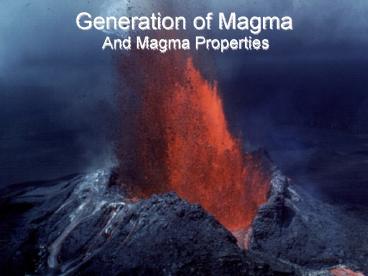Generation of Magma - PowerPoint PPT Presentation
1 / 16
Title:
Generation of Magma
Description:
Solid components are silicate minerals that have already crystallized. ... Occurs when rock ascends as a result of convective upwelling (recall that the ... – PowerPoint PPT presentation
Number of Views:1527
Avg rating:3.0/5.0
Title: Generation of Magma
1
Generation of Magma
- And Magma Properties
2
(No Transcript)
3
What is magma?
- Magma is completely or partially molten material,
which cools to form an igneous rock. - The liquid portion is called the melt (usually
ions of silica and oxygen, with lesser amounts of
magnesium, aluminum, potassium, calcium, sodium,
and iron). - Solid components are silicate minerals that have
already crystallized. - As the magma body cools, the number of solids
increases.
4
The Role of Heat
- Geothermal gradient
5
The Role of Pressure
- Pressure increases with depth in the Earth
- Melting occurs at higher temperatures with depth
because of confining pressure ? the greater the
pressure, the higher the melting point - When confining pressure drops, decompression
melting occurs - Occurs when rock ascends as a result of
convective upwelling (recall that the mantle is
solid, but flows at very slow rates.
6
Role of Volatiles
- Magma also contains dissolved gasses
- Water Vapor (H2O), carbon dioxide (CO2) Sulfur
Dioxide (SO2) - Water actually lowers the melting point of rock
- Consequently, wet rock at depth has a lower
melting point than dry rock
7
Crystallization and Magma Evolution
- Process of magma cooling is called
crystallization. (Bowens reaction series)
8
Magmatic differentiation
9
The Nature of Volcanic Activity
- Factors that affect magma viscosity
- A magmas viscosity is directly related to its
silica content
Vs.
Which volcano do you think was formed from a more
silica rich magma?
10
Magmas and Rock types
The key to volcanic rocks
11
Magma and Partial Melting
- Most magma produced from a process called partial
melting. - As rock begins to melt, minerals with the lowest
melting point melt first - Vice verse with crystallization
12
Where do different rocks form?
13
Formation of Basaltic Magma
- Originates from partial melting of an ultramafic
rock called peridotite. - Peridotite is composed of iron-rich minerals such
as those that are major constituents of the
mantle. - Basltic magma upwells at hotspots or spreading
centers (midicean ridges). - Occurs in subduction zone settings, but does not
make it to the the surface. - Little to no silica incorporated into the mix.
- Ascend rapidly to the Earths surface causing
large outflows of lava (i.e. Hawaii)
14
Formation of Andesitic and Granitic Magmas
- Interaction between basaltic magma and the
continental crust. - As basaltic magma migrates upward, it can melt
the crust. - The crust provides incorporated silica into the
magma making it chemically different from the
basaltic magma.
15
Andesitic Magma
- Andesitic magmas may evolve from a process called
magmatic differentiation. - If you look at Bowens reaction series, as
basaltic magma crystallizes, silica-poor
ferromagnesian minerals crystallize first. - Remaining melt is now silica-rich ? causing the
andesitic rocks - These magmas are called secondary magmas
16
Granitic Magma
- Derived from partial melting of the continental
crust and/or the end product of crystallization
of andesitic magma. - Higher in silica
- More viscous (thicker)
- Frequently lose their mobility before making it
to the surface and produce produces large
plutonic structures (cool underground). - When they do make it to the surface, cause
explosive eruptions































